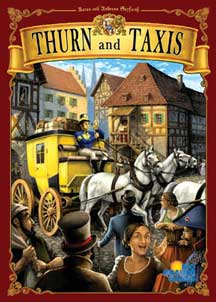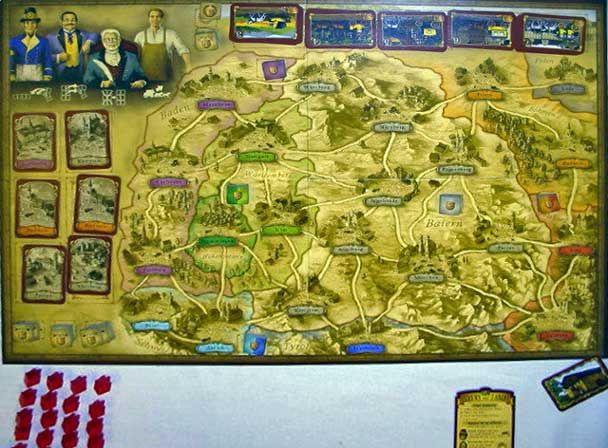Pevans
Thurn & Taxisreviewed by Pevans |
 Well, it’s just won the Spiel des Jahres (Game of the Year) in Germany and there’s been quite a buzz about Thurn und Taxis since it first appeared: let’s see if it lives up to its reputation. Interestingly, the game’s author is given as Karen and Andreas Seyfarth. Andreas Seyfarth, of course, gave us Puerto Rico. Karen Seyfarth is the missus and, according to Herr Seyfarth’s interview with Tom Vasel, “she did work much on all of my games with playtesting, suggestions and critiques”. This time they’re joint designers (as they were on Max und Moritz in 1991). But enough of this, what about the game?
Well, it’s just won the Spiel des Jahres (Game of the Year) in Germany and there’s been quite a buzz about Thurn und Taxis since it first appeared: let’s see if it lives up to its reputation. Interestingly, the game’s author is given as Karen and Andreas Seyfarth. Andreas Seyfarth, of course, gave us Puerto Rico. Karen Seyfarth is the missus and, according to Herr Seyfarth’s interview with Tom Vasel, “she did work much on all of my games with playtesting, suggestions and critiques”. This time they’re joint designers (as they were on Max und Moritz in 1991). But enough of this, what about the game?
The game is about the beginnings of the mail service in Germany. (The game’s title comes from the noble house of Thurn und Taxis, which started postal services in Europe in the sixteenth century.) The board is a map showing regions of what is now Germany and neighbouring countries and centred on Bavaria. The board also shows the main towns – from Lodz (Poland) in the top right corner to Basel (Switzerland) in the bottom left – and the network of roads that connects them. This is how the mail is carried.
The other major component is a deck of cards. Each card shows one of the towns on the board. Players use these to build up routes. Half a dozen cards are laid out and, each turn, you must pick up one of these. You must also play one in front of you, adding to or starting a route. The cards in front of you must reflect the road connections on the board. Thus if you start with Basel, you can place Zurich to one side of it and/or Freiburg to the other – these are the only two roads out of Basel. There are three other roads out of Freiburg and two from Zurich. As you can see, once you start a route, you are severely constrained in the cards you can play. In particular, you can only add to the ends of the route, you can’t insert cards in the middle. This gives a certain spatial awareness element to the game. It is quite possible to start a route that you then have to scrap as you run out of the right cards. Or you may want to do this for tactical reasons.
The board also constrains routes. Notably, there’s only one road to Lodz. This makes it a tough place to include in a route unless you have the right cards before you start. The road from Lodz goes to Pilsen, in Bohemia (or the Czech Republic as it is known these days). I’m intrigued that the only other Bohemian town on the board is Budweis. Do Pilsener and Budweiser ring any bells? I find it a bit more than coincidental that two major centres of the brewing industry are the only Bohemian towns worthy of mention. I think one of the Seyfarths likes their beer! I’ll go for a Budvar (as Budweis is known in Czech).
Once a route reaches three cards long, a player can declare it complete. This lets them place pieces (wooden ‘houses’) in the towns (where they don’t already have a house) to show the extent of their network. They can either place a house in each town in the route that is in one region or one house in a town in each different region that the route includes. Say you have a route of Lodz (Poland) – Pilsen (Bohemia) – Budweis (Bohemia) – Linz (Austria). You could put houses in Pilsen and Budweis as they’re both in the same region. Or one in each region: Poland, which has to be Lodz, Austria, which means Linz, and Bohemia, which is either Pilsen or Budweis. This gives some direction to planning your routes.
Completing a route can also get you some points. First, players can claim a stagecoach card if they’ve achieved a route of the minimum length. The smallest is 3, the largest 7. You can only take the next highest even if your route is longer. Second, you may be able to take one (or more) of the various bonus chips that are available. If you meet the requirements, you take the highest value chip still available for that bonus. So it’s not just the first person to achieve something that gets a bonus, but they’ll get the biggest bonus. There are bonuses for getting long routes. There are bonuses for having a presence in all the towns in a region or group of regions: Bohemia + Austria, for example. There are also bonuses for having at least one house in each region apart from Bavaria (it’s the largest region on the board). Finally, there is a 1-point bonus for being the person to trigger the end of the game.
And the game usually reaches its end when someone claims their 7 coach. At this point, everybody who hasn’t taken their turn yet this round gets to do so. Then players score up and the player with the most points wins. Each player gets the points for their biggest coach and their bonuses and loses points for any houses they haven’t placed yet. As the 7 coach is worth ten points and the 6 coach only 7, getting that 7 coach is a decent step on the way to winning. Of course, it’s quite possible that another player or two will be able to get a 7 coach as well, so you need a few more points.
Now that you’ve seen what the scoring opportunities are, you’ll have an idea of what players are trying to do in building their routes. Getting pieces into a region, spreading across regions and making longer routes. As the bonus for something is bigger the earlier you get it, there’s a definite incentive to be first to earn a particular bonus. And that means keeping an eye on what the other players are up to. I like the fact that it’s still worth going for a bonus even if someone else gets there first. It also means that there are always ways to score points available to players.
Another way the game can end is when somebody uses up all their houses. This means you really need to keep an eye on how many the other players still have – and how many you’ve got. Even if you are racking up bonuses, you can’t afford to fall too far behind other players in getting your houses on the board or you’ll really suffer from the penalties for having pieces left over. And it is quite possible that one player building towards a route that’s 7 long will be thwarted by someone else using up their pieces.
There is one other thing to mention. I’ve said that each turn a player gets to pick up a card and play a card and may declare a route complete – thus getting any coach and/or bonus for this. There’s one other thing they do: use one of the four special actions available to them. One of these allows them to pick up a second card; another to play a second card. These are the abilities used most often in the game, allowing a player to draw two and play one or draw one and play two each turn. The third action is to replace the set of face-up cards – usually in the hope of getting something more suitable to pick up. The final special action allows a player to claim a coach card that is up to two higher than the length of route they have just completed. This can be very useful, especially when it lets you claim that 7 coach with a route that’s only 5 long. The thing to remember, when planning your turn, is that you only get to use one special action each turn! It’s all too easy to get used to drawing or playing two cards a turn and forget that you can only do one when you want to claim that your route is two longer than it is.

The mechanics of the game are relatively straightforward, leaving players with the challenge of planning what they’re doing. The aim is to score points faster than the other players and, ideally, grab a 7 value coach (and end the game) before anyone else. There are plenty of things to think about along the way, but the game is not overwhelming and certainly doesn’t outlast its welcome. In fact, I’d say it usually ends a bit more quickly than players expect – something to be aware of when you first play the game.
Thurn und Taxis is a clever, tactical game without being too demanding. It requires players to think about what they’re doing – both within each turn and longer term – and take decisions. Players are constrained by the availability of cards and must work within these limitations. However, there are lots of ways of scoring points, so there are always things to do each turn. What this game doesn’t have is any interaction between players. Players need to keep an eye on what others are doing in order to avoid competing for the same cards and bonuses and so that they aren’t surprised by a game-ending move. Apart from that, each pursues their own path, expanding their routes and racking up their own scores. It’s my kind of game!
Overall, I like it a lot, but I recognise that it’s not going to be everybody’s cup of tea. It gets 9/10 on my highly subjective scale.
Thurn und Taxis is a tactical board game designed by Karen and Andreas Seyfarth and published by Hans im Glück (in German) and Rio Grande (in English). It is for 2-4 players, aged 10+, and takes about 45 minutes to play.